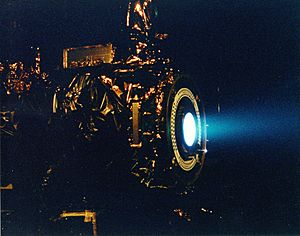Ion thruster facts for kids
An ion thruster is a special type of engine for spacecraft. It uses tiny electrically charged particles called ions to push the spacecraft forward. Imagine using a very gentle push that never stops! This engine takes a long time to speed up. But it uses very little fuel. This means it can travel much farther than regular rockets.
Ion thrusters can't launch a spacecraft from Earth. They don't push hard enough to escape Earth's gravity. So, a regular rocket must carry them into outer space. Once in space, they are perfect for long journeys. They need electricity to work. Spacecraft using ion thrusters carry solar panels or a nuclear reactor for power.
Contents
How Ion Thrusters Work
What are Ions?
Ions are atoms that have an electric charge. They can be positive or negative. Ion thrusters create these charged particles. Then they use static electricity or magnetism to push them out the back. This push creates thrust. It's like a very gentle but constant breeze.
Slow but Steady Power
Unlike a regular rocket, an ion thruster doesn't give a big, sudden push. Instead, it gives a small, continuous push. Over time, this small push builds up to a very high speed. Think of it like a bicycle slowly gaining speed. Eventually, it can go very fast. This makes ion thrusters great for long trips across the Solar System.
Fuel Efficiency
One of the best things about ion thrusters is how little fuel they use. Their fuel lasts much longer than the fuel for traditional rockets. This means spacecraft can travel for many years. They can reach distant planets or asteroids. This saves a lot of space and weight on the spacecraft.
Ion Thrusters in Space
The Dawn Mission
In 2011, NASA launched a space probe called Dawn. This probe used an ion thruster. Its mission was to visit two large objects in the asteroid belt. First, it traveled to the asteroid Vesta. The ion thruster helped it get there.
Then, in 2015, the same thruster brought Dawn to the dwarf planet Ceres. Dawn orbited both Vesta and Ceres. It studied them up close. This mission showed how useful ion thrusters are for long, multi-stop journeys in space.
Images for kids
See also
 In Spanish: Propulsor iónico para niños
In Spanish: Propulsor iónico para niños




